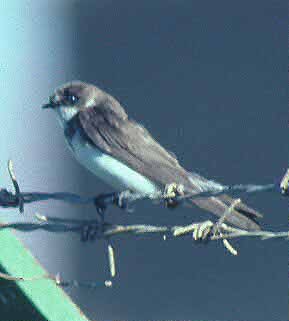MISIDENTIFICATION #6: "BANK SWALLOW"
 The swallows on the line (left-hand bird was our thumbnail) seem to be
brown above, cleanly white below (including well-defined white throats),
and have breastbands. Classic Bank Swallows, no? No. They are both juvenal
Tree Swallows, a much over-looked problem in northern California. There
are two excellent papers on this subject: the late Claudia Wild's 1985
"Unraveling the mysteries of brown swallows," Birding 17: 209-211,
and Nick Lethaby's 1996 "Identification of Tree, Northern Rough-winged,
and Bank Swallows," Birding 28: 111-116. As Nick says: "it is possible
for experienced birders to have prolonged, close-range views of a 'brown
swallow' and disagree on what it was!"
The swallows on the line (left-hand bird was our thumbnail) seem to be
brown above, cleanly white below (including well-defined white throats),
and have breastbands. Classic Bank Swallows, no? No. They are both juvenal
Tree Swallows, a much over-looked problem in northern California. There
are two excellent papers on this subject: the late Claudia Wild's 1985
"Unraveling the mysteries of brown swallows," Birding 17: 209-211,
and Nick Lethaby's 1996 "Identification of Tree, Northern Rough-winged,
and Bank Swallows," Birding 28: 111-116. As Nick says: "it is possible
for experienced birders to have prolonged, close-range views of a 'brown
swallow' and disagree on what it was!"
I've made this mistake before and I think it happens more commonly than
recognized. I have become distrustful of mid-May to mid-August claims of
Bank Swallows away from colonies; I think Bank Swallow migration is mostly
March-April and late August-early October. Tree Swallows have fresh juvs
from early June (maybe late May) into early August, so it is the summer
claims of vagrants that are most suspect. While juv Trees get patchy washes
of bluish to be back by August, very fresh birds (like the ones in the
photo) are all dark-brown above. The glossy-blue, white-tipped tertials
(see upper right bird) are diagnostic of Tree Swallow, but many observers
fail to look for them. While most young Tree Swallows have a "smudgy" appearance
to the breastband, and on most birds the band is paler in the center, there
are birds with "obvious" breastbands, and they can especially appear so
when seen only in flight or not studied carefully.

A real Bank Swallow (adult) is shown at right. Its tertials
are the same plain brown as the back but the rump (not seen in the photo)
is paler than the back or tail. A great mark is the pointed wedge of dark
extending down from the middle of the breastband towards the belly, just
visible in this shot.
The Lethaby article includes a fine photo of several Banks Swallows
on a line with one Tree Swallow; the Tree Swallow looks gigantic! Likewise,
a Bank Swallow with a group of Tree Swallows (the more typical case in
California) looks tiny. I am most suspicious of those claims of Bank Swallow
that fail to mention this size difference.
Tree Swallows are common and widespread throughout northern California.
Bank Swallows are very local and the statewide populations are considered
threatened. There are a couple colonies in southern Monterey Co., others
at Año Nuevo Pt. and Ft. Funston, San Francisco (on the coast) and
a few along the northern Sacramento River (in the Central Valley). There
are isolated colonies at Fall River Mills, Shasta Co., and several east
of the Sierran-Cascade divide from Bridgeport to Tulelake. But overall
Bank Swallows are rare in the state, and migrants are unusual. More care
needs to be taken with claims of migrants away from known colonies, and
especially claims from June-August.
PHOTOS: The young Tree Swallows
were
at Moss Landing, Monterey Co., in Aug 1991; the adult Bank
Swallow (or, more properly where photographed, the Sand Martin)
was at Sharm-el-sheik in the Sinai, then Israeli-occupied (now Egypt),
in Oct 1981. Both photos © D. Roberson.
TOP
BACK TO
TEN MOST MISIDENTIFIED PAGE
GO TO MONTEREY PAGE
GO TO
IDENTIFICATION PAGE
GO TO HOME PAGE
GO TO LIST OF BIRD
FAMILIES OF THE WORLD
 The swallows on the line (left-hand bird was our thumbnail) seem to be
brown above, cleanly white below (including well-defined white throats),
and have breastbands. Classic Bank Swallows, no? No. They are both juvenal
Tree Swallows, a much over-looked problem in northern California. There
are two excellent papers on this subject: the late Claudia Wild's 1985
"Unraveling the mysteries of brown swallows," Birding 17: 209-211,
and Nick Lethaby's 1996 "Identification of Tree, Northern Rough-winged,
and Bank Swallows," Birding 28: 111-116. As Nick says: "it is possible
for experienced birders to have prolonged, close-range views of a 'brown
swallow' and disagree on what it was!"
The swallows on the line (left-hand bird was our thumbnail) seem to be
brown above, cleanly white below (including well-defined white throats),
and have breastbands. Classic Bank Swallows, no? No. They are both juvenal
Tree Swallows, a much over-looked problem in northern California. There
are two excellent papers on this subject: the late Claudia Wild's 1985
"Unraveling the mysteries of brown swallows," Birding 17: 209-211,
and Nick Lethaby's 1996 "Identification of Tree, Northern Rough-winged,
and Bank Swallows," Birding 28: 111-116. As Nick says: "it is possible
for experienced birders to have prolonged, close-range views of a 'brown
swallow' and disagree on what it was!"
